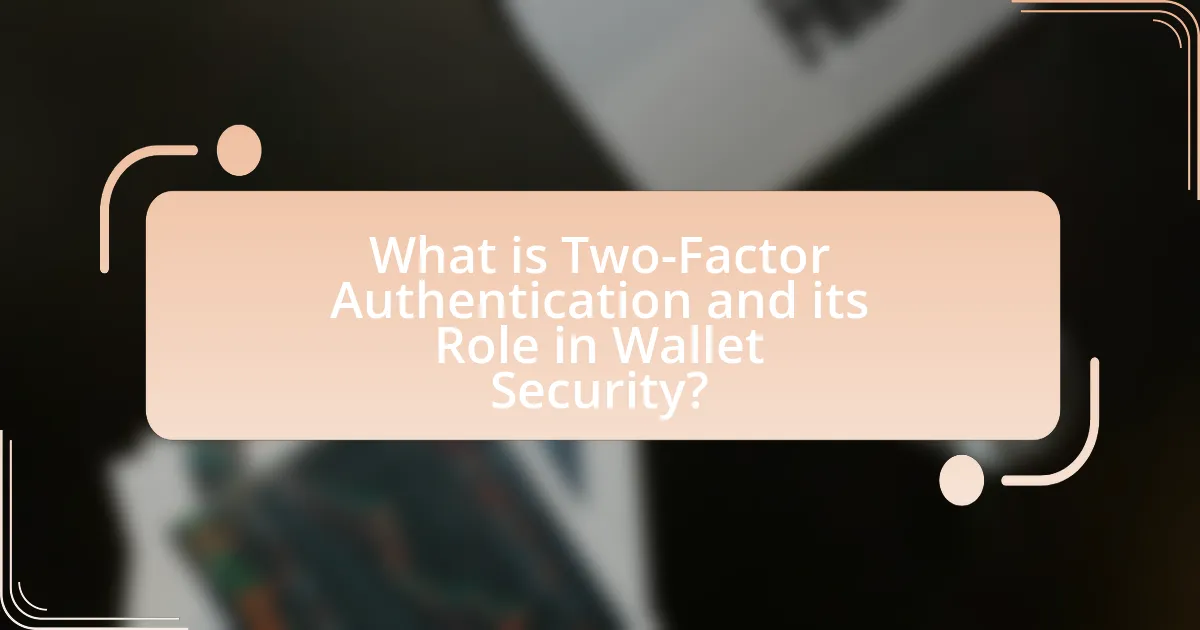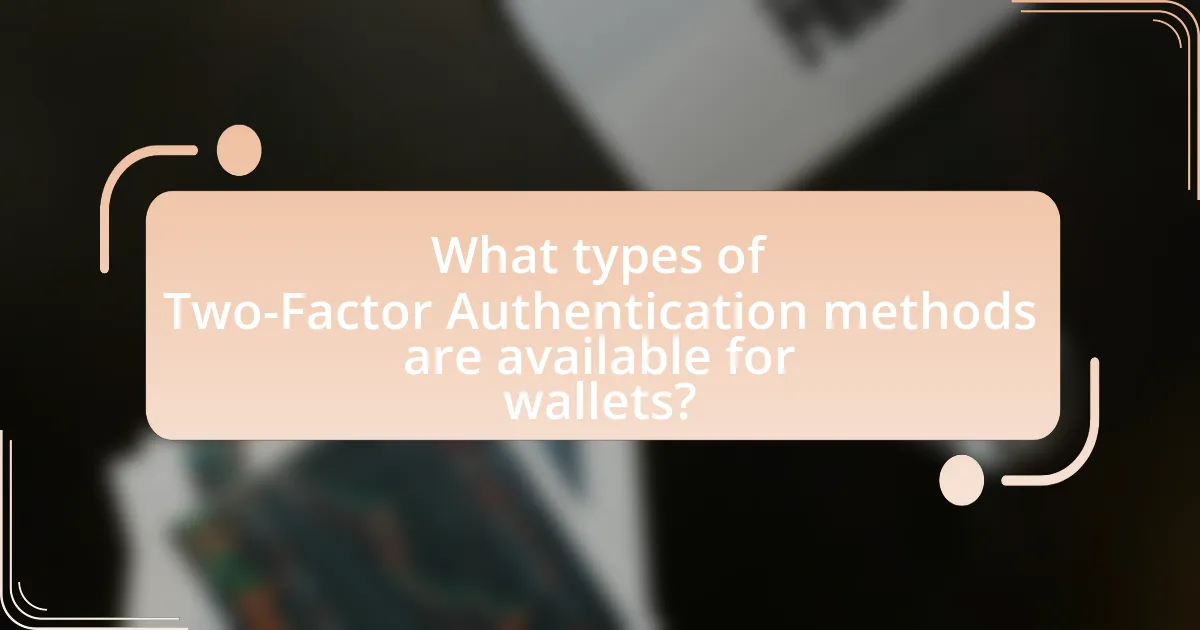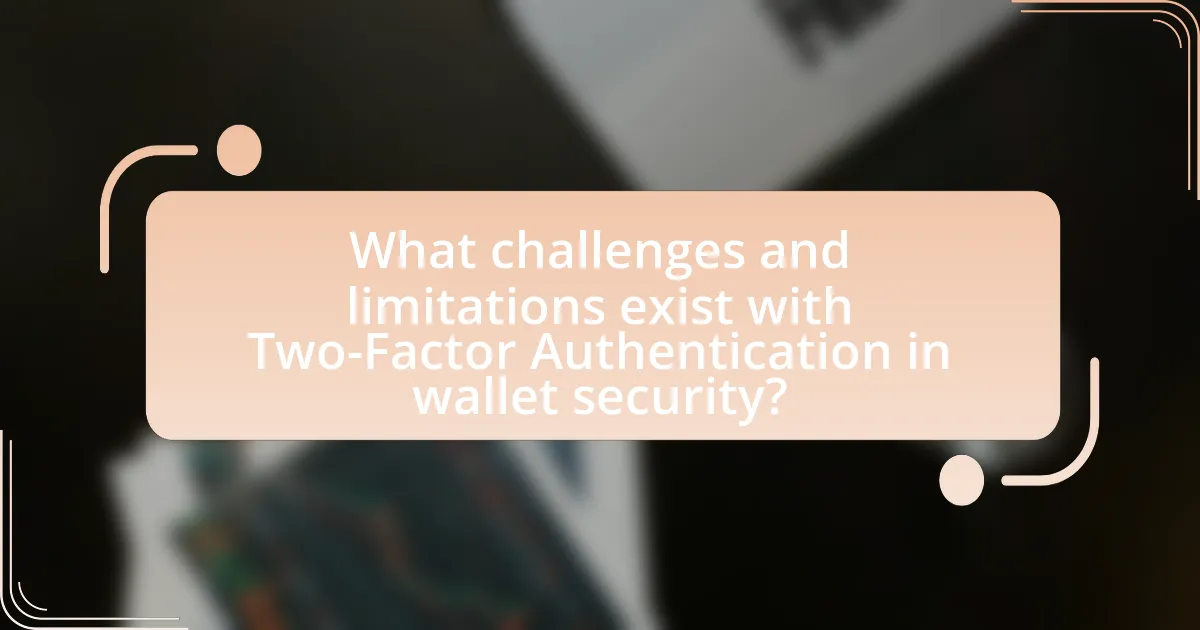Two-Factor Authentication (2FA) is a critical security measure that enhances wallet security by requiring two distinct forms of verification for account access. This article explores the mechanisms of 2FA, including its key components, methods of implementation, and the significant risks it mitigates, such as unauthorized access and phishing attacks. It also examines various 2FA methods available for wallets, including SMS-based verification, authenticator apps, and hardware tokens, while discussing their advantages and limitations. Furthermore, the article highlights best practices for users to effectively manage 2FA, the challenges associated with its use, and future trends in authentication technology, emphasizing the importance of adopting robust security measures to protect digital assets.

What is Two-Factor Authentication and its Role in Wallet Security?
Two-Factor Authentication (2FA) is a security process that requires two different forms of identification to access an account, enhancing wallet security significantly. By combining something the user knows, like a password, with something the user has, such as a mobile device for receiving a verification code, 2FA reduces the risk of unauthorized access. According to a study by Google, accounts secured with 2FA are 100 times less likely to be compromised than those without it. This dual-layered approach ensures that even if a password is stolen, the wallet remains protected, as the second factor is still required for access.
How does Two-Factor Authentication enhance wallet security?
Two-Factor Authentication (2FA) enhances wallet security by requiring two forms of verification before granting access, significantly reducing the risk of unauthorized access. This method typically combines something the user knows, like a password, with something the user possesses, such as a mobile device for receiving a one-time code. According to a study by Google, implementing 2FA can block up to 99.9% of automated attacks, demonstrating its effectiveness in safeguarding sensitive information.
What are the key components of Two-Factor Authentication?
The key components of Two-Factor Authentication (2FA) are something you know (knowledge factor) and something you have (possession factor). The knowledge factor typically involves a password or PIN that the user knows, while the possession factor usually requires a physical device, such as a smartphone or hardware token, that generates a one-time code. This dual requirement significantly enhances security by ensuring that even if one factor is compromised, unauthorized access is still prevented. For instance, a study by the University of Cambridge found that 2FA can reduce the risk of account compromise by up to 99.9% when implemented correctly.
How does the implementation of Two-Factor Authentication work in wallets?
Two-Factor Authentication (2FA) in wallets enhances security by requiring two forms of verification before granting access. Typically, this involves something the user knows, like a password, and something the user possesses, such as a mobile device that receives a one-time code. When a user attempts to log in, they first enter their password, followed by a code sent to their device, which must be entered to complete the login process. This dual-layer approach significantly reduces the risk of unauthorized access, as an attacker would need both the password and the physical device to gain entry. Studies indicate that accounts with 2FA are 99.9% less likely to be compromised, underscoring its effectiveness in wallet security.
Why is Two-Factor Authentication important for wallet users?
Two-Factor Authentication (2FA) is important for wallet users because it significantly enhances security by requiring two forms of verification before granting access. This additional layer of protection helps prevent unauthorized access, even if a user’s password is compromised. According to a study by Google, 2FA can block 100% of automated bots and 96% of phishing attacks, demonstrating its effectiveness in safeguarding sensitive information. By implementing 2FA, wallet users can better protect their digital assets from theft and fraud.
What risks does Two-Factor Authentication mitigate in wallet security?
Two-Factor Authentication (2FA) mitigates risks such as unauthorized access, phishing attacks, and credential theft in wallet security. By requiring a second form of verification, typically a one-time code sent to a user’s mobile device, 2FA adds an additional layer of security beyond just a password. This dual verification process significantly reduces the likelihood of unauthorized transactions, as attackers would need both the password and access to the second factor to gain entry. According to a study by Google, implementing 2FA can block 99.9% of automated attacks, demonstrating its effectiveness in enhancing wallet security against common threats.
How does Two-Factor Authentication protect against unauthorized access?
Two-Factor Authentication (2FA) protects against unauthorized access by requiring two distinct forms of verification before granting access to an account. This process typically involves something the user knows, like a password, and something the user possesses, such as a mobile device that receives a one-time code. By implementing this dual-layer security, even if an attacker obtains the password, they cannot access the account without the second factor, significantly reducing the risk of unauthorized access. Studies show that accounts secured with 2FA are 99.9% less likely to be compromised compared to those that rely solely on passwords.

What types of Two-Factor Authentication methods are available for wallets?
Two-Factor Authentication (2FA) methods available for wallets include SMS-based verification, authenticator apps, hardware tokens, and biometric authentication. SMS-based verification sends a one-time code to the user’s mobile device, while authenticator apps generate time-sensitive codes that the user must enter. Hardware tokens are physical devices that produce codes, and biometric authentication uses unique physical traits, such as fingerprints or facial recognition, to verify identity. These methods enhance wallet security by requiring a second form of verification beyond just a password, significantly reducing the risk of unauthorized access.
What are the most common Two-Factor Authentication methods used?
The most common Two-Factor Authentication (2FA) methods used are SMS-based verification, authenticator apps, and hardware tokens. SMS-based verification sends a one-time code to the user’s mobile device, which must be entered to gain access. Authenticator apps, such as Google Authenticator or Authy, generate time-based codes that users input alongside their passwords. Hardware tokens, like YubiKey, provide a physical device that generates or transmits a code for authentication. These methods enhance security by requiring something the user knows (password) and something the user has (code or token), significantly reducing the risk of unauthorized access.
How do SMS-based and app-based authentication differ?
SMS-based authentication and app-based authentication differ primarily in their method of delivering one-time codes. SMS-based authentication sends codes via text messages to a user’s mobile phone, which can be intercepted by attackers through SIM swapping or phishing. In contrast, app-based authentication generates codes within a dedicated application, such as Google Authenticator or Authy, which are not transmitted over the network and are therefore less vulnerable to interception. Research indicates that app-based methods are generally considered more secure due to their resistance to common attacks associated with SMS, such as man-in-the-middle attacks and social engineering.
What are the advantages and disadvantages of hardware tokens?
Hardware tokens provide enhanced security for two-factor authentication, offering advantages such as strong protection against phishing attacks and unauthorized access due to their physical nature. They generate unique codes that are time-sensitive, making it difficult for attackers to replicate access. Additionally, hardware tokens are not susceptible to malware that targets software-based authentication methods, further securing user accounts.
However, hardware tokens also have disadvantages, including the risk of loss or damage, which can result in users being locked out of their accounts. They may also require additional costs for procurement and maintenance, and their physical presence can be inconvenient for users who prefer mobile or software-based solutions. Furthermore, if a user forgets to carry the token, it can hinder access to critical services.
How can users choose the best Two-Factor Authentication method for their wallets?
Users can choose the best Two-Factor Authentication (2FA) method for their wallets by evaluating the security features, usability, and compatibility of available options. Strong 2FA methods include hardware tokens, authenticator apps, and SMS-based verification, with hardware tokens generally offering the highest security due to their offline nature, which protects against phishing attacks. According to a study by Google, using an authenticator app can reduce the risk of account compromise by 90% compared to using only a password. Users should also consider the ease of use and whether the chosen method integrates seamlessly with their wallet service, ensuring that security does not hinder access.
What factors should be considered when selecting a Two-Factor Authentication method?
When selecting a Two-Factor Authentication (2FA) method, factors such as security level, user convenience, compatibility, and recovery options should be considered. The security level is crucial; methods like hardware tokens or biometric authentication provide stronger protection compared to SMS-based codes, which are susceptible to interception. User convenience affects adoption; methods that are easy to use, such as mobile authenticator apps, encourage consistent use. Compatibility with existing systems is essential to ensure seamless integration, as not all 2FA methods work with every platform. Lastly, recovery options must be evaluated to ensure users can regain access if they lose their 2FA device, with backup codes or alternative verification methods being important for user support.
How does user convenience impact the choice of Two-Factor Authentication?
User convenience significantly influences the choice of Two-Factor Authentication (2FA) methods, as users prefer solutions that are easy to implement and use. When 2FA options are user-friendly, such as biometric authentication or push notifications, adoption rates increase, leading to enhanced security. Research indicates that 70% of users abandon security measures that are perceived as cumbersome (Source: Cybersecurity & Infrastructure Security Agency, 2021). Therefore, the balance between security and convenience is crucial; if a 2FA method is too complex, users may opt out, undermining the intended security benefits.

What challenges and limitations exist with Two-Factor Authentication in wallet security?
Two-Factor Authentication (2FA) in wallet security faces several challenges and limitations, primarily including susceptibility to phishing attacks, reliance on mobile devices, and potential user error. Phishing attacks can compromise the second factor, such as SMS codes, allowing unauthorized access despite 2FA being enabled. Additionally, if users lose access to their mobile devices or if those devices are compromised, the effectiveness of 2FA diminishes significantly. User error, such as entering incorrect codes or failing to recognize phishing attempts, further undermines the security that 2FA aims to provide. These factors collectively highlight the vulnerabilities inherent in relying solely on 2FA for wallet security.
What are the common vulnerabilities associated with Two-Factor Authentication?
Common vulnerabilities associated with Two-Factor Authentication (2FA) include SIM swapping, phishing attacks, and man-in-the-middle attacks. SIM swapping occurs when an attacker tricks a mobile carrier into transferring a victim’s phone number to a new SIM card, allowing them to intercept 2FA codes. Phishing attacks involve deceiving users into providing their 2FA codes through fraudulent websites or communications. Man-in-the-middle attacks enable attackers to intercept and manipulate communications between the user and the authentication service, compromising the security of the 2FA process. These vulnerabilities highlight the need for additional security measures beyond 2FA to protect sensitive information effectively.
How can phishing attacks compromise Two-Factor Authentication?
Phishing attacks can compromise Two-Factor Authentication (2FA) by tricking users into revealing their authentication codes or credentials. Attackers often create fake websites or send deceptive emails that mimic legitimate services, prompting users to enter their login information and 2FA codes. Once the attackers obtain these details, they can gain unauthorized access to the user’s account, bypassing the security that 2FA is meant to provide. Research indicates that 90% of data breaches involve phishing, highlighting the effectiveness of this method in undermining security measures like 2FA.
What are the implications of losing access to Two-Factor Authentication methods?
Losing access to Two-Factor Authentication (2FA) methods significantly increases the risk of unauthorized access to accounts and sensitive information. Without 2FA, accounts become more vulnerable to attacks such as phishing, where attackers can easily compromise passwords alone. A study by Google found that 2FA can block 100% of automated bots and 96% of targeted attacks, highlighting its critical role in securing accounts. Therefore, the absence of 2FA not only jeopardizes personal data but also undermines the overall security framework designed to protect digital assets.
How can users effectively manage Two-Factor Authentication for their wallets?
Users can effectively manage Two-Factor Authentication (2FA) for their wallets by enabling it through a reliable authentication app, such as Google Authenticator or Authy. This method enhances security by requiring a second form of verification, typically a time-sensitive code generated by the app, in addition to the password.
To ensure optimal management, users should regularly back up their 2FA recovery codes in a secure location, as losing access to the authentication app can lock them out of their wallets. Furthermore, users should avoid using SMS-based 2FA due to its vulnerability to interception. According to a study by the Cybersecurity & Infrastructure Security Agency, using app-based 2FA significantly reduces the risk of unauthorized access compared to SMS methods.
What best practices should users follow to enhance their wallet security?
To enhance wallet security, users should implement strong, unique passwords and enable two-factor authentication (2FA). Strong passwords should consist of at least 12 characters, including a mix of uppercase letters, lowercase letters, numbers, and special symbols, which significantly reduces the risk of unauthorized access. Enabling 2FA adds an additional layer of security by requiring a second form of verification, such as a text message code or authentication app, making it more difficult for attackers to gain access even if they have the password. According to a study by Google, 2FA can block 100% of automated bots and 96% of phishing attacks, demonstrating its effectiveness in enhancing security.
How can users recover from Two-Factor Authentication issues?
Users can recover from Two-Factor Authentication (2FA) issues by utilizing backup codes or recovery options provided during the initial setup. Most services that implement 2FA offer backup codes that can be used when the primary authentication method is unavailable, such as losing access to a mobile device. Additionally, users can often reset their 2FA settings by verifying their identity through email or SMS, or by contacting customer support for assistance. This recovery process is crucial as it ensures continued access to accounts while maintaining security protocols.
What are the future trends in Two-Factor Authentication for wallet security?
Future trends in Two-Factor Authentication (2FA) for wallet security include the increased adoption of biometric authentication methods, such as facial recognition and fingerprint scanning, which enhance security by leveraging unique physical traits. Additionally, the integration of hardware security keys, like YubiKey, is expected to rise, providing a more robust layer of protection against phishing attacks. The use of adaptive authentication, which assesses user behavior and context to determine the level of security required, is also gaining traction. According to a report by Gartner, by 2025, 70% of organizations will implement adaptive authentication methods, reflecting a shift towards more dynamic security measures. These trends indicate a move towards more user-friendly yet secure authentication processes in wallet security.
How is technology evolving to improve Two-Factor Authentication methods?
Technology is evolving to improve Two-Factor Authentication (2FA) methods through advancements in biometrics, adaptive authentication, and the integration of hardware security keys. Biometric methods, such as fingerprint and facial recognition, enhance security by using unique physical traits, making unauthorized access more difficult. Adaptive authentication analyzes user behavior and context, adjusting security measures based on risk levels, which allows for a more user-friendly experience while maintaining security. Additionally, hardware security keys, like YubiKey, provide a physical layer of security that is resistant to phishing attacks, as they require the user to possess the key to authenticate. These innovations collectively strengthen the reliability and effectiveness of 2FA, addressing vulnerabilities in traditional methods.
What role does biometric authentication play in the future of wallet security?
Biometric authentication will play a crucial role in enhancing wallet security by providing a unique and reliable method of user verification. As cyber threats evolve, traditional password-based systems become increasingly vulnerable, making biometric methods—such as fingerprint scanning, facial recognition, and iris scanning—more appealing due to their difficulty to replicate or steal. Research indicates that biometric systems can reduce fraud rates significantly; for instance, a study by the National Institute of Standards and Technology found that biometric authentication can achieve accuracy rates exceeding 99% in user identification. This high level of accuracy, combined with the convenience of biometric methods, positions them as a key component in the future of secure wallet transactions.
What practical tips can enhance the effectiveness of Two-Factor Authentication in wallet security?
To enhance the effectiveness of Two-Factor Authentication (2FA) in wallet security, users should implement the use of authenticator apps instead of SMS-based codes. Authenticator apps, such as Google Authenticator or Authy, generate time-sensitive codes that are less susceptible to interception compared to SMS, which can be compromised through SIM swapping or phishing attacks. Additionally, users should enable backup codes provided by the wallet service, ensuring access in case the primary 2FA method fails. Regularly updating passwords and ensuring they are strong and unique further fortifies security, as weak passwords can undermine the benefits of 2FA. Finally, users should be cautious of phishing attempts and only enter their 2FA codes on trusted websites, as attackers often create fake sites to capture sensitive information.